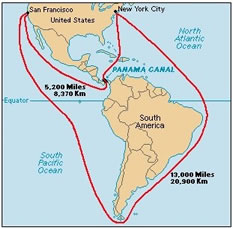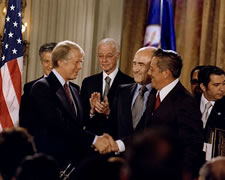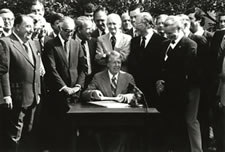Panama Canal Treaties

The Panama Canal had a huge impact on transportation and the lives of Americans. There were two Panama Canal treaties involved. The first treaty made the building of the canal possible. The Panama Canal linked the Atlantic and Pacific Oceans, cutting across the Isthmus of Panama. It made a trip from New York to California much easier. The second treaty was important to travel because it gave the United States the right to defend the canal from any military threats. The first treaty was signed in 1903. It was between the United States and Panama, and it gave the United States the right to build and operate the Panama Canal. The canal was completed in 1914 and it was a great success. It shortened a ship's trip between New York City and San Francisco to less than 5,200 miles. It saved ships the trip around South America, which was a distance of more than 13,000 miles. However, people in Panama were not happy because they wanted control of the canal. They wanted the United States to leave.
The solution to this problem was a second treaty, which was the result of many years of negotiations. The United States didn’t want to give up control, but the people in Panama had different plans. The second treaty is known as the Torrijos-Carter Treaty. This neutrality treaty said that the United States had the permanent right to defend the canal from any threats. In addition, as of midnight on January 1, 2000, Panama would be in full control of the canal, but not responsible for the canal’s defense. It was signed by the United States and Panama in Washington D.C. on September 7, 1977. The treaty is named after its two signatories, US President, Jimmy Carter and Panama’s leader, Omar Torrijos. This important treaty was ratified by the United States Senate on March 16, 1978. The Panama Canal treaties were vital for ships traveling to California. They made sure that the Panama Canal was built and kept it safe. The completion of this canal improved travlers' journeys both economically, and time-wise.

Camp David Accords
Egypt and Israel had technically been at war since Israel's founding in 1948, and the latter had occupied the Sinai Peninsula (Egyptian territory) during the Six-Day War of 1967. The peace treaty that Israel and Egypt eventually signed on March 26, 1979 closely reflected the Camp David Accords. It was President Carter who had intervened to rescue the deteriorating peace talks with personal visits to both countries. The treaty formally ended the state of war that existed between the two countries, and Israel agreed to withdraw from the Sinai Peninsula in stages. The treaty also provided for the establishment of normal diplomatic relations between the two countries.Establishment of U.S. diplomatic relations with the People's Republic of China
The U.S. President Jimmy Carter sent his Secretary of State, Vance, and his White House National Security Assistant, Zbigniew Brzezinski, to visit China in August 1977 and May 1978 respectively to hold talks on the normalization of Sino-U.S. relations. At the time when Vance visited China, the U.S. Government was not yet finally determined to accept the three principles China raised for establishing diplomatic relations between China and the United States. During his visit, Brzezinski expressed that President Carter was determined to normalize Sino-U.S. relations before his first term ended, and that the United States was ready to accept the three principles set forth by China for the establishment of diplomatic relations. He also expressed the hope that when the U.S. side said it expected a peaceful solution to the Taiwan question which was purely an internal affair of China, it would not meet with an obvious refutation from China. After nearly half a year's negotiations, the two sides finally reached an agreement: “the United States acknowledges the Chinese position that there is but on China and Taiwan is part of China.”Department of Energy

On August 4, 1977, President Jimmy Carter signed into law the Department of Energy Organization Act of 1977, which created the Department of Energy. The United States Department of Energy (DOE) is a Cabinet-level department of the United States government concerned with the United States' policies regarding energy and safety in handling nuclear material. Its responsibilities include the nation's nuclear weapons program, nuclear reactor production for the United States Navy, energy conservation, energy-related research, radioactive waste disposal, and domestic energy production. DOE also sponsors more basic and applied scientific research than any other US federal agency; most of this is funded through its system of United States Department of Energy National Laboratories.
Department of Education

The United States Department of Education is a Cabinet-level department of the United States government. It was recreated by the Department of Education Organization Act and signed into law by President Jimmy Carter on October 17, 1979. It began operating on May 16, 1980. The primary functions of the Department of Education are to "establish policy for, administer and coordinate most federal assistance to education, collect data on US schools, and to enforce federal educational laws regarding privacy and civil rights.”